Mold is a fungus that thrives in moist environments. If you are using a wet palette for painting miniatures, whether to mix or thin paints, it is important to take steps to prevent mold from growing on it. A wet palette with mold growing on it can be a safe place for bacteria to breed and spread as well. For most people, mold is just an unsightly nuisance that needs to be cleaned away in order to get back the use of their wet palette. However, if you have a compromised immune system with any kind or a respiratory or pulmonary disease, you should take more serious precautions to clean any mold out of your wet palette.
Mold can easily grow on a hobby wet palette if you are not careful about preventing it. In this article, I’ll tell you some of the common sources of mold on a wet palette and what steps are necessary to prevent it.
RELATED: BEST WET PALETTES FOR MINIATURE PAINTERS
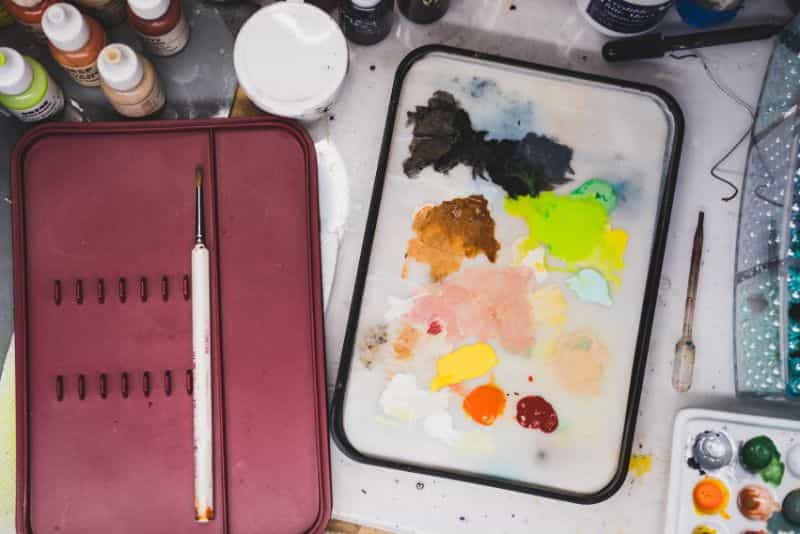
What is “Mold”?
Mold is a type of fungus, according to the EPA, which thrives in moist environments. Mildew is a type of mold and considered an “early-stage” mold. Unlike mold, mildew does not penetrate the surface it grows on. Mildew is easier to spot on the surface where it grows and, as such, easier to clean. While both molds and mildew may grow on your wet palette; mold is the the more troublesome growth you may see on your wet palette.
Important Facts About Mold for Miniature Painters Who Use a Wet Palette
Most types of molds will grow into the surface they are on, such as the palette paper of your wet palette. They will penetrate the material and this makes molds very hard to remove, even with harsher methods, e.g., scrubbing, strong detergents.
Of course, molds are a normal part of the environment, existing almost everywhere that moisture and oxygen are available. They belong to the kingdom Fungi and dwell in moist locations such as soil, plants, and dead or decaying material. Molds take part in nature by breaking down organic waste such as fallen leaves, dead trees, and other trash.
Mold can grow on many types of porous surfaces, such as wood, paper, carpets, foods, and insulation materials (the stuff behind your walls). If you haven’t noticed already, water moisture is a key player in helping mold grow and proliferate on a surface. Materials that have porous textures where air (oxygen) can enter and waste products, like carbon dioxide, can escape also make mold likely to appear.
What are the Hazards of Mold on a Wet Palette?
Mold can be unsightly, but it is not usually hazardous in small quantities. But if you have respiratory problems, mold can be potentially dangerous. When you breathe in mold spores or mold dust, it can cause allergic and asthmatic reactions and even trigger asthma attacks. For those who lick their paint brushes, bristles contaminated with mold can lead to an allergic reaction in some people.
Mold growth is not usually visible on a wet palette because molds typically grow in layers. Mold will begin working its way into your wet palette and this will most likely show up as a black or green spot. When you catch it in the early stages, mold is much easier to clean off your wet palette than when it’s fully grown.
RELATED: PAINTBRUSH CARE AND MAINTENANCE FOR NEWBIES AND NOVICES
Here are some of the health risks and complications associated with mold growth:
- Skin rashes
- Dizziness
- Headaches
- Asthma attacks
- Sneezing
- Runny nose
- Red eyes
Why Should You Keep Mold From Growing on Your Wet Palette?
Mold can cause a number of problems if it grows on your wet palette for painting miniatures. Not only is it unsightly and often difficult to remove, but it can also be a breeding ground for bacteria. If you have a compromised immune system, mold can cause serious health problems.
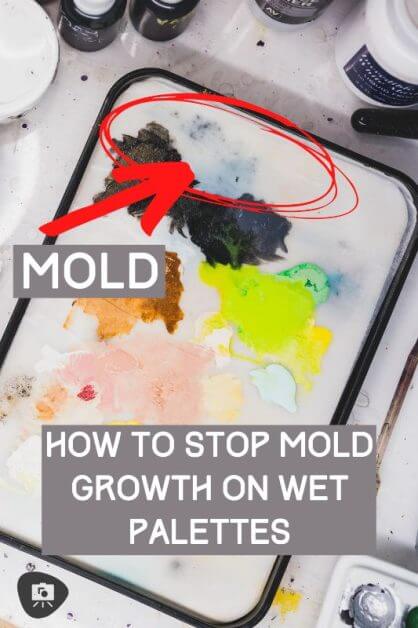
If you are using a wet palette to mix paints or thin them, the mold can contaminate your paints and cause them to spoil. Finally, mold also smells after a while, which makes the whole miniature painting affair unpleasant–Nobody likes wet palette smells!
By controlling moisture and reducing mold growth, you can:
- Improve your wet palette experience
- Paint miniatures with more reliable results
- Reduce bad smells from creeping into your hobby space
- Avoid potential health concerns
How Quickly Can Mold Grow on a Wet Palette?
Mold and fungi can grow on almost any moist surface, including wet palettes. They can even grow on surfaces that are not damp, but only if there is some moisture in the air.
Based on some information I learned about mold and mildew growth around a home (source#1, source#2), if you live in a humid environment, then it is possible for mold to begin growing within 24-48 hours of creating your wet palette. If you live in a drier climate, it could take a bit longer, maybe two or three days of creating your new wet palette before mold could potentially grow on it.
It doesn’t matter if you use the store-bought palette paper that came with your wet palette, e.g., included paper with the Masterson Sta Wet Palette, or the DIY parchment paper that many hobbyists including myself use when they make their own wet palettes, mold/mildew is likely to grow if given the chance.
Are There Any Products That Can Be Used to Kill Mold Growth?
There are two effective products that hobbyists have used to kill mold growth: bleach and alcohol. Chlorine bleach (e.g., Clorox) will kill mold on most surfaces, but you must be careful when using it around organic materials like paper products as it can promote tearing and fiber wear, which is a no-no for your miniature paints on a wet palette (source). You can also use pure isopropyl alcohol (also known as rubbing alcohol) to kill mold. Alcohol is effective at killing mold and mildew, but it will not prevent future mold/mildew growth (source).
Note that these products should only be used when you’re cleaning your wet palette before using it. Avoid exposing your acrylic model paints to bleach or alcohol. These chemicals and severely degrade the quality and finish of your paints. Bleach can remove color vibrancy from paint (that’s it job in some cases, e.g., laundry whites), and rubbing alcohol breaks up water surface tension and makes water-based paints dry much faster.
What Sources Can Cause Mold to Grow on Your Wet Palette?
There are several sources that can cause mold and bacteria to begin growing on the surface of your wet palette. Here are some examples:
- Moisture from the air (humidity) and/or exposed water (e.g., damp paper towels or palette cloths)
- Dirty sponges, brushes and paint rags used for cleaning palettes and removing excess paint
- Mold spores lurking around the studio (e.g., air ducts, vents)
- Dust and debris that find their way onto your wet palette surface
- Existing mold growth on tools like paintbrushes and sponges (most likely from improper cleaning)
- The water itself in which you place your wet palette
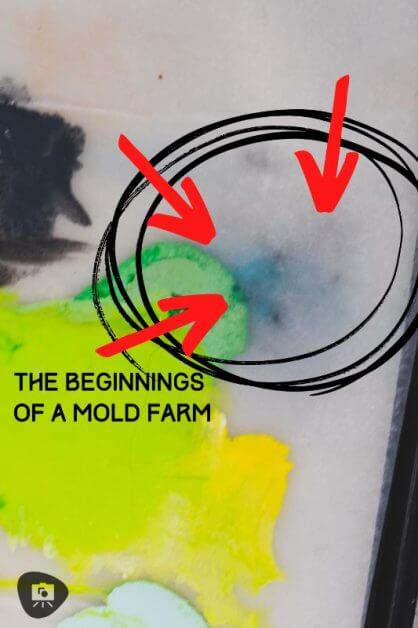
Here are 10 Quick Tips for How to Deal with Mold Growth on Your Wet Palette:
Please note that even if you do everything suggested below, your wet palette may still grow mold. Mold spores are everywhere in the air all around us, so it is always best to keep your wet palette as clean as possible at all times.
1. Use distilled water for mixing paints. Tap water contains bacteria, minerals, and other substances that are not conducive to preventing mold growth on your wet palette. Using distilled water for mixing avoids contamination of your paint with unwanted mineral deposits from tap water.
2. Boil your water before using it in your wet palette. If you don’t want to bother with buying or making distilled water, then simply boil your tap water before soaking your sponge or foam pad. Boiling water will destroy almost any bacteria or mold that is already in the tap water. Boiling water is also a good medium for cleaning your sponge when you’re cleaning out your wet palette.
3. Clean the inside of the wet palette, including the lid, after use every few days. Regular cleaning of your entire wet palette will go a long way to preventing mold growth. Of course, how often you clean your wet palette depends on how much of a problem mold is in your area. Not every hobby space and environment is the same.
To clean your wet palette, a simple rinsing with warm water and anti-bacterial soap will do a good job. Just make sure the water you’re using is clean, too. For more aggressive cleaning of your wet palette, you can submerge your sponge in boiling hot water or rinse the sponge in a 1:1 mixture of water to vinegar. Just make sure you completely rinse out any soap or other cleaning solutions from your sponge before using it in your wet palette again.
4. Replace your palette paper at the earliest sign of mold (presence of green or blue-green spots). Once mold spores on your palette grow, they are almost impossible to stop. Replace the palette paper and clean out the sponge (using above tip in #3) to keep your your palette free of mold. It is worth mentioning again that you should clean out your entire wet palette every month if possible or sooner if you’ve noticed mold growth in the past.
5. Keep your brushes clean using soap. Mold can grow on the bristles of brushes, especial sable natural hair tufts. The humidity within brushes can promote the growhth of mold and bacteria. When you start using your wet palette, those mold spores can transfer from your paint brushes to the palette surface. Certain cosmetic brush soaps naturally prevent mold and other unwanted organisms from proliferating on your brushes.
7. Keep the wet palette tray dry when you’re not using it. If you’re not planning on painting for a while, allow your entire wet palette to dry out. This will completely prevent the chance mold will grow on your wet palette when you’re away from the hobby. Certainly, other contaminent may settle on the palette, so it is a good idea to wash out your wet palette (or replace the sponge/paper) before rehydrating and using it again.
8. For DIY wet palettes, use synthetic sponges or foam pads for household cleaning tasks. Synthetic foam and sponges tend to be resistent to bacteria and mold growth. If you use paper towels or regular bathing sponges, you may want to replace or clean these out more often. Paper towels or disposible cloth sheets should be thrown out instead of washed, as they tend to degrade over time in a wet palette.
9. Use rubbing alcohol or ammonia to wipe down the inside of the wet palette lid. Products like isopropyl alcohol (i.e., rubbing alcohol) or window glass cleaners contain will quickly kill any mold spores present on the surfaces of your wet palette. Just make sure to avoid getting these chemicals in the water of the wet palette, as they can make your acrylic paint do odd things, e.g., change color, runny, or become sticky.
10. Keep a copper coin or wire in your wet palette (by the sponge and moist). Copper sulfate (a trace mineral in old copper coins or wire) and other metals, like zinc or nickel, can inhibit the growth of mold, fungi, and bacteria that can grow on your wet palette (source). However, too much metal can also interfere with how some paints behave and cause other problems, e.g., rust, discoloration, so be careful with introducing metals to your wet palette. If you’re unsure, always run a test with your wet palette on a model you don’t mind messing up on.
Frequently Asked Questions (FAQ)
Why is mold and bacterial growth bad for miniature painting?
Mold and bacteria can cause a number of problems for miniature painters:
- Discolor paint or make it runny or sticky.
- Cause acrylic paint to crack or peel when it dries.
- Mold and bacteria can cause a bad smell to emanate from the wet palette.
- Some miniature painters lick their brushes. Mold and bacteria can cause the paints on the palette to become contaminated, which can lead to sickness if ingested.
How can I prevent mold & bacteria growth on my wet palette?
There are a recommended things that you can do to prevent mold and bacteria growth on your wet palette (based on community feedback):
- Keep the wet palette tray clean and free of organic matter (dirt, food, some types of pigments, etc.)
- Make sure to allow the wet palette to dry out completely between uses
- Use a sponge or paper towel that is resistant to mold and bacteria growth
- Wipe down the inside of the wet palette lid with rubbing alcohol or ammonia
- Keep a copper coin or wire in your wet palette (by the sponge and moist)
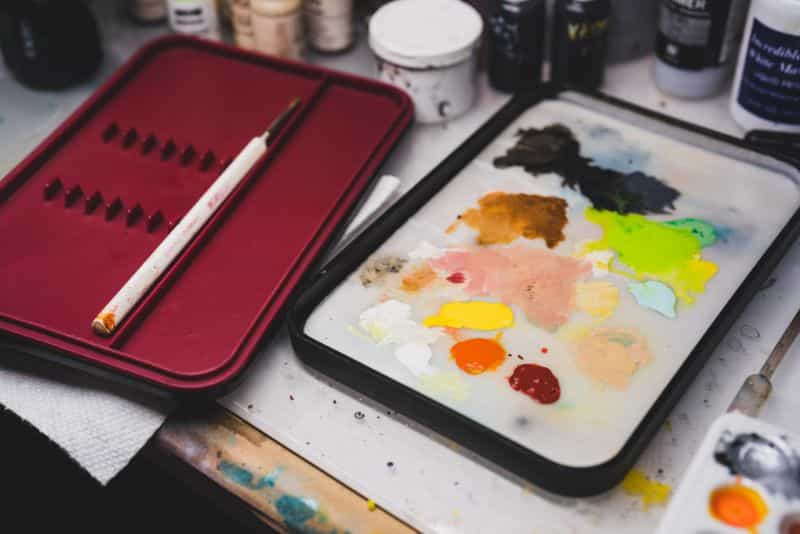
What’s the best material to use for DIY wet palette paper?
There is no definitive answer for what the best material is to use for DIY wet palette paper. Some miniature painters swear by using baking parchment paper, because it’s cheap and semi-absorbent (permeable to water, but not paint). Here’s a full review of what we think is the best paper for DIY wet palettes.
How often should I replace my wet palette paper?
It’s recommended to use a new piece of DIY wet palette paper for every session, but if you are planning on using the paint that’s been sitting on the wet palette for days at a time, then it’s recommended to change out your DIY wet palette paper after 1-2 weeks.
Conclusion
So, I’ve discussed the common sources of mold on a wet palette and what steps are necessary to prevent it. I also provided some suggestions about how to reduce the risk of contaminating paint in a wet palette with mold or bacterial growth.
I hope this article helped to clear up some questions you might have about keeping a mold-free wet palette for your miniature painting hobby.
I’m sure I missed some information as there’s a lot out there. If you found a great way to prevent mold from growing on your wet palette, please let me know! Leave a comment below. I’d love to hear from you.
Happy Miniature Painting!!! 🖖




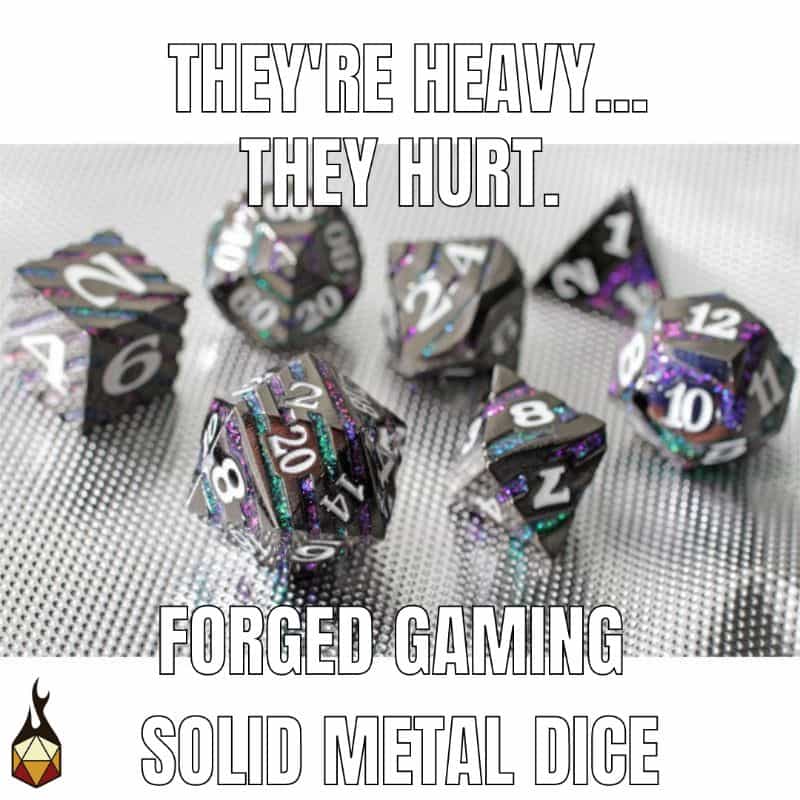
Tangible Day on YouTube (Miniatures and More!)


Why not some oxygenated water? (Peroxide) on the pad? I used it before to prevent mold on paper maché and works like a charm.
I use food safe 1% hydrogen peroxide to keep mine mold free. Just add a little from a dropper bottle to your wet palette water, not enough to interfere with paint, but enough to make it less habitable to uninvited guests.
I will need to try this out! Thanks! I’ll add a note to the post too 🙂